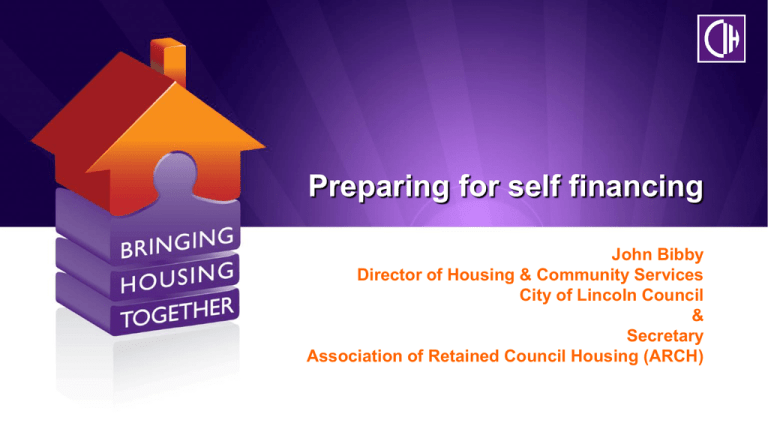Preparing for self
advertisement

Preparing for self financing John Bibby Director of Housing & Community Services City of Lincoln Council & Secretary Association of Retained Council Housing (ARCH) My brief Self financing from ARCH point of view The view from Lincoln as an example: Sustainability on current figures Preparations we are making Risks/opportunities Key issues from Lincoln’s perspective The ARCH perspective Argued for reform of HRA finance system Welcome proposals for self-financing Final settlement may not be as good as original prospectus But compared to staying with current system over a long term represents a good deal for majority of stock retained authorities Some authorities will face real challenges in short term Real opportunity to provide sustainable long term future for Council housing The ARCH perspective Comparisons between 2010 “prospectus” & February “settlement” No real surprises/some concerns: – – – – – – – RTB receipts remain pooled Inclusion of allocation for aids & adaptations Acknowledgement of impact of planned demolitions Uplift in M&M allowances broadly similar Withdrawal of HRA PFI from deal Potential to re-open settlement (is this good or bad?) Net exchequer receipt of £6.5m compared to £4.8m Arguments about basis of settlement are over Begin planning implementation & financing the settlement The view from Lincoln Lincoln: facts & figures 7,940 council properties Self-financing valuation £60.3m Indicative borrowing limit £60.3m Subsidy Capital Financing Requirement £41.1m Self financing settlement £19.2m Actual opening debt below subsidy settlement by c£8m giving some headroom from outset Average rent £59.80 compared to Formula rent £61.00 (11/12) Rental income £24,718m (11/12) Decent Homes met by December 2010 with ongoing potential non-decent homes arising in future years Lincoln: Our approach (1) Accept shape of final deal is clear (but final figures may change) No choice about entering self financing Start reviewing and updating our Business Plan Housing Business Plan must be a “real” plan Looking at self-financing to provide opportunities for “real” long term business planning: – – – – – Future pro-active asset management of property & land Opportunities for estate regeneration & redevelopment Asset disposal and acquisitions New build? Shape of capital programme & “local offer” on Home Standard & Service Standards Lincoln: Our approach (2) Develop/refine Asset Management Strategy, Treasury Management Strategy & Risk Management Strategy Set up Self-financing Implementation Team (S-fit): – Multi-disciplinary finance, housing, property, maintenance – Identify any capacity issues& support requirements taking into account general fund cuts in back-office support – External support Develop financial modeling & key assumptions/risks Lincoln: Our approach (3) Analyse the settlement: – – – – – Test debt settlement for sustainability Update expenditure assumptions Update income assumptions Model impact of RTB sales/receipts Confirm planned demolitions/remodelling Consider treasury management approach: – Review technical & accounting arrangements and impact of CIPFA guidance – Model impact on HRA & General Fund – Consider impact on debt pooling arrangements, depreciation & introduction of memorandum balance sheet – Identify key financial decisions on run-up to implementation – Borrowing strategy, use of reserves & any “headroom” between SCFR & actual debt Lincoln: Our approach (4) Identify asset management challenges & opportunities: – – – – Revisit stock condition data and investment requirements over next 30 yrs Update costs of maintenance of minimum Decent Homes Standard Cost out affordability of any “Local Offers” over and above Decent Homes Standard Update cost of health & safety and other works: • Asbestos management/fire prevention works • HHSRS/Energy efficiency Revisit R&M procurement strategy – Longer term financial planning & assurance over rental income stream may give opportunities for procurement savings Explore opportunities for collaboration with Registered Providers, private developers for regeneration/remodelling of estates Lincoln in self financing (Debt profile) Lincoln in self financing (Capital programme v resources) Lincoln in self financing (HRA cashflow/balances) £200,000 In-Year Cashflow £150,000 HRA Balance £100,000 £50,000 -£50,000 35 33 31 29 27 25 23 21 19 17 15 13 11 9 7 5 3 1 £0 Lincoln: Summary outputs (1) Total capital need of £294m over 30 years but review of phasing of investment need underway. Initial 5 year capital programme potential of £52.4m (£9.9m pa compared to £8.5m) Debt able to be paid down by year 20 (but case for maintaining debt at managed level with commitment of rental surpluses to expanded programme) Delivery of capital and debt planning would leave HRA revenue reserve in substantial surplus in year 30 Actual opening debt below SCFR giving some further headroom in plan from outset Lincoln: Summary outputs (2) Although settlement numbers will no doubt change members and tenants need to begin to make decisions about use of headroom & priorities in the Business Plan between: – Further investment in stock (revised local offer on Home Standard over & above Decent Homes) – Further investment in services (re-instating some of management services cut in 2006 to make DRF contribution to support stock retention) – Potential small new build programme – Combination of all 3 Key financial outputs can be worked up – Preparing for transaction (PWLB/Private market/mix) – Debt charges (de-pooling HRA) – Depreciation (approach/CIPFA guidance) Lincoln: Key issues Review of phasing of investment needs Confirmation of intention & timing of property disposals/demolitions/remodelling Splitting of debt into separate HRA pool Financing the transaction (indicative £19.2m) Tenant & member attitude to the settlement “Preparing for self-financing – not long left”











